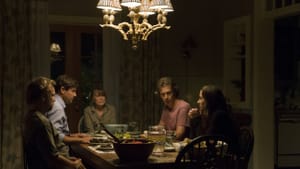Stay in the Loop
BSR publishes on a weekly schedule, with an email newsletter every Wednesday and Thursday morning. There’s no paywall, and subscribing is always free.
How slow can you go?
‘Bloodline’ on Netflix

The world has sped up tremendously in the last half century, and that includes the pace of storytelling. In thrillers, especially, we’ve all gotten used to fast cuts and breakneck action — building tension slowly, letting the dread accumulate drop by drop, as Hitchcock did, is a thing of the past. Or was, until Netflix gave us Bloodline.
The Rayburns have run an inn in the Florida Keys for 45 years. Mother Sally (Sissy Spacek) is glad that ne’er-do-well oldest son Danny (Ben Mendelsohn) has returned for the anniversary celebration; father Robert (Sam Shepard), not so much. It’s up to Dad to decide whether to allow Danny to return to the fold (how feudal!), but he turns over the decision to his other three children: John (Kyle Chandler), a detective with the local sheriff’s department; Meg (Linda Cardellini), a lawyer; and Kevin (Norbert Leo Butz), who works in a boatyard.
And thus we embark on a very, very slow unfolding of all of the secrets that all of the family members are keeping. Something bad, very bad, happened decades ago. And one or more of the Rayburns did something bad, very bad, then. And some of them continue to do bad things, though “we’re not bad people,” John insists in a voiceover that is played and replayed. We’re left to piece together the events of the past through snippets of flashbacks that are repeated, like John’s voiceover, until their significance begins, slowly, to become clear.
The feeling of dread is also built by flash-forwards. J ohn’s “we’re not bad people” mantra is confessional in tone, though what he’s confessing, and to whom, doesn’t become clear till much later. Might it have something to do with the repeated glimpses of a scene in which John is dragging Danny through a swamp in torrential rain?
ohn’s “we’re not bad people” mantra is confessional in tone, though what he’s confessing, and to whom, doesn’t become clear till much later. Might it have something to do with the repeated glimpses of a scene in which John is dragging Danny through a swamp in torrential rain?
Current events
Most of the story, of course, takes place in the present. The Rayburns are all dealing with the problems facing the Florida Keys. John and his partner Marco (Enrique Murciano), who’s Meg’s longtime boyfriend, are working on a complicated case involving human trafficking and drug smuggling. Meg is facilitating negotiations with one group of developers, who want to build a luxury resort; Kevin fears his small boatyard will be squeezed out if the neighboring marina is sold to another group of developers.
Danny does stick around. He works at the inn and spends time with his mother; he also hangs out with his seedy pal Eric (Jamie McShane) and his old girlfriend, Eric’s sister Chelsea (Chloë Sevigny). Has he been scapegoated by his father and siblings, or is he the villain they think he is? Is he a charmer or a manipulator? Do his actions arise from expediency or malice? Mendelsohn — the least-known member of the cast — is a wonderful surprise. He leaves the audience unclear to the end whether any of the multiple personae Danny shows reflect his true intentions or are perceptions distorted through his family’s expectations.
Neither fast nor furious
This is leisurely storytelling: It’s not going to appeal to the Fast and Furious crowd, and it’s not trying to. Me, I’m willing — nay, happy — to settle in with a show and see what happens, but Bloodline sorely tried my patience: It crossed the line between “deliberate” and “glacial.”
Modern cable TV dramas usually run in 13-episode seasons, and Netflix has picked up that model for its streaming series. Since there’s no set time slot to fill, episodes are often of varying lengths. Bloodline is 13 episodes long, with episodes ranging from 49 to 65 minutes. But the creators should either have gone with even shorter episodes or chosen to tell the story in fewer episodes.
The problem is that after a certain point, the repetition of the flashes to the past and future stop creating atmosphere and become padding. For instance, one character comes into possession of a cassette tape (yes, that’s how long ago some of the Bad Things happened) and listens to it over and over — forcing us to listen to it over and over. Another character doesn’t have access to the cassette, so he has similar flashbacks inspired by the transcript of its contents. Some of the present-day plotlines are equally superfluous: They neither illuminate character nor move the plot forward, directly or indirectly (by creating red herrings).
Bloodline’s creators were clearly inspired by Hitchcock’s classic thrillers, but for good or ill, times have changed. Have you tried to watch Vertigo lately? You might find yourself muttering, as I did, “Get on with it.” Bloodline, too, would have benefitted had someone told the creators to get on with it.
What, When, Where
Bloodline. Created by Glenn Kessler, Todd A. Kessler, and Daniel Zelman. Available on Netflix.
Sign up for our newsletter
All of the week's new articles, all in one place. Sign up for the free weekly BSR newsletters, and don't miss a conversation.

 Judy Weightman
Judy Weightman